


My first computer job was on an IBM punch card verifier - note the full-size keyboard on the right. It was like sitting at a desk. An operator typed in the data which was converted to punched holes (numerals, letters and special characters) and then somebody had to "proof" the data or "verify" it.
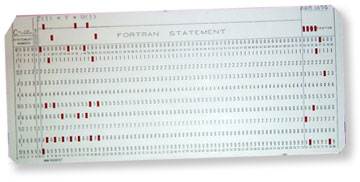
I didn't last long at this job. It was kind of tedious, but the concept of digital data and how information was converted to binary values appealed to me. Data files today are essentially the same, except the volume has gone beyond the relative exosphere. We have completely lost the traditional value of efficiency in the digital environment. Otherwise, why would we require personal Terabyte drives?
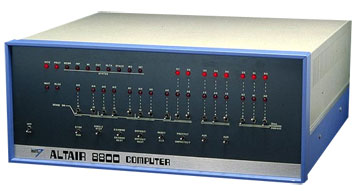
The "Altair 8800" was called the World's first minicomputer kit to "rival commercial models" and was the on the cover of Popular Electronics (January 1975). There are several theories about how it got its name - but they all involve space travel and stars. The Altair is considered the spark that started the microcomputer or personal computer revolution. All I know is, I wish I had one.

By the early '80s I had a Tandy 1000 at home and was working on a mainframe "text-editing/soft layout" system called ATEX while at The Financial Post. It may seem archaic today, but I made my first "typeset" graphics on it. The Tandy, on the other hand, used a dot matrix display / command-line interface and used 5.25 inch floppy discs for both system and user data files. I don't ever want to go back there again.
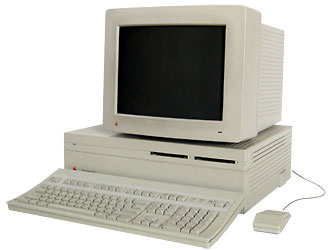
The Post is where I first encountered a mouse and the Apple Macintosh II. From there I went to The Toronto Star and had to take a technical step backwards. Their editorial art department was hopelessly dated. They were still using Macintosh SEs, but I was brought in as the Sys Admin to update the Dept. After a few years with them, I decided I had to get out of the newspaper business.
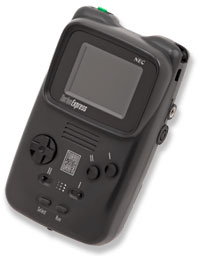
By the early '90s I was getting into computer games and had a SEGA Genesis and an NES and even the NEC Turbo Express (above). This little beauty sold for about $400. It had a back-lit LED display and you could play it in the dark. It could also load the exact same game carts as the regular console version.
This device turns up in the Tony Scott film Enemy of the State (1998) where an environmental scientist (Jason Lee) accidentally captures a murder on video. He digitizes it onto an electronic storage card and sticks it into his Turbo Express. Of course, it can't play the file. In fact, I don't know of any personal computer that could interface with that sort of storage technology, but then, it's just a movie - and movies often contain absurd ideas about technology . . . but, hey, that is an enormous topic all by itself.
My NEC Turbo Express can be seen in video clips in Jewels II. It's on Professor Bhandam's desk. I used to think I'd still like to have one today, but with the new high res (HD), hand-held mobile devices today, I have changed my mind. I prefer the SONY Vita.
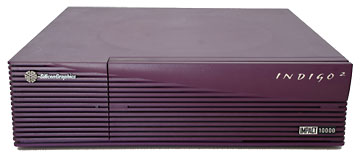
In the late '90s I was still using Apple processors, but I also had an incredibly expensive SGI - Silicon Graphics, Inc Indigo 2 Impact R10000. SGI was started by Jim Clark back in 1981 and their processors were the ones that brought high-end CGI into cinema.
SGIs were the processors used on Terminator 2 - running Alias software (PowerAnimator / Maya) as well as on the first Toy Story. These incredible computers are gone now and most people don't seem to remember them.
They have been surpassed by the new generation personal computers, but SGI does get a logo cameo in Stephen Hopkins 1998 film Lost in Space - starring William Hurt and Heather Graham. The company is mentioned as co-sponsor of the "hypergate" project - for faster-than-light travel. It's funny going back and seeing the movie, because now SGI seems to be a fictional company from an erroneous future.
BTW, we used SGI computers to model and render Jewels II.
Today, I use a Windows laptop on the road, a Linux tower at home (Ubuntu) and an iMac at the office. Besides those OSs, there are also mobile wireless devices running their own operating systems. Of course, none of this hardware would be here if not for a couple of extraordinary people. . .
In our world of personal computers we owe a lot to Douglas Engelbart who basiclly invented the mouse, the windows interface idea and the concept of networking computers together.
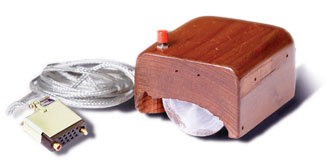
Of course, the true father and creator of the programmable, electronic digital computer was Tommy Flowers who worked with Alan Turing at Bletchley Park. Flowers designed Colossus.
Up until recently, it was a matter of international secrecy, but a replca of Colossus was completed in 2007 and can be seen at the National Museum of Computing in Buckinghamshire, England.
< PREVIOUS